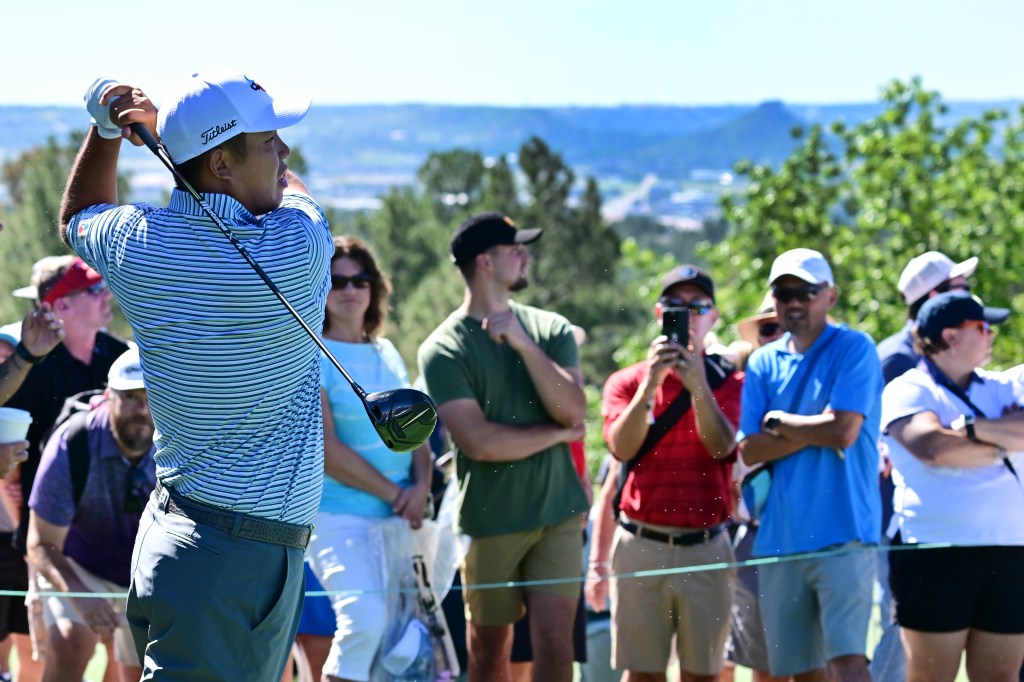CASTLE ROCK — There is no humidor at Castle Pines Golf Course.
When the 50 best players on the PGA Tour launch balls into the thin Front Range air this week at the BMW Championship, they are going to fly and fly … and fly a little more.
“It should be interesting. The ball is going to go really far this week, and the golf course is in great shape,” Patrick Cantlay said. “I think the biggest thing is paying attention to trajectory. If you get the ball a little up in the air, it can go quite a bit further.”
At 8,130 yards, this will be the longest course in PGA Tour history. It is not expected to “play” as the longest for seasoned pros, but there will be adjustments for everyone with the altitude.
Players will spend the lead-up to the tournament figuring out how far they are hitting it, and then translate that onto a very long course. Colorado native Wyndham Clark noted that his 7-iron flies about 20 yards farther here, as an example.
If anyone on the tour doesn’t like math, this probably won’t be their favorite week on the calendar.
“The only weird thing we have sometimes is when you’re hitting over water and you’re hitting a 4-iron from 265 yards,” Xander Schauffele said. “It’s kind of weird when you think of it that way, but once you and your caddie break it down — it looks far away, but the number you have in your head seems like you’re at sea level, for me at least.”
There will be plenty of attention on Clark, who grew up here and has years of experience playing at altitude. He’s played Castle Pines more than anyone in the field by a significant margin.
The PGA hasn’t been at Castle Pines since 2006 and hasn’t been in Colorado since 2014. The circumstances could give Clark a bit of a home-field advantage, but not as much as one a decade or two ago.

“We’re all so good now and our books are so good, our information is so good, our teams are so good that I think guys just one time seeing the golf course have a really good idea for it,” Clark said. “I know some of the nuances that maybe other people don’t know. I feel like I have some tricks up my sleeve when I get into certain situations. Maybe it’ll come with shot selection and distance control.”
Not only is the course extremely long, but there will be opportunities for the players to let it rip. It starts with the first hole, which is a whopping 662 yards but also a long way down the hill with a fairly wide-open landing area.
The official PGA record for longest drive is 477 yards, set by Max Homa in January at The Plantation Course at Kapalua in Maui. There have been 16 drives during the ShotLink era, which began in 2000, that have measured 450-plus yards at a PGA event. Half of them have been struck at Kapalua.
There could be more this week at Castle Pines, thanks to both the thin air and changes in elevation.
“I might have to intentionally hit more club than some guys off of tees just so I can catch my breath by the time I get to my golf ball,” Schauffele said. “I think if you’re first up on some par-3s after a long walk, you might be huffing and puffing a little bit more than normal.”
As Cantlay noted, trajectory will be key for managing the altitude-induced distance boosts. There are other challenges to deal with. Schauffele noticed the wind changes, which could change how the players attack from hole to hole or day to day.

Clark also noted that the course, at least as of Tuesday morning, is pretty soft. He’s played it before when the ground was harder, and even more distance needed to be added for after the ball lands.
If it stays soft, that means planning to carry the ball farther in the air.
“Typically when I’ve played here in the past, if the flag is at 150 (yards), you want to land it 140 and that gets to 150,” Clark said. “It really is that firm usually. Right now I’m landing it right on 150. If it doesn’t change much, guys are going to be throwing darts at the flags.
“I expect some lower scores.”
Want more sports news? Sign up for the Sports Omelette to get all our analysis on Denver’s teams.
Originally Published:

